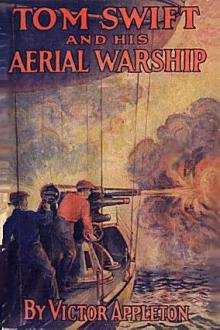Tom Swift and His Submarine Boat by Howard R. Garis (best e reader for manga TXT) 📕

While father and son were deep in a discussion of the apparatus of the submarine, there will be an opportunity to make the reader a little better acquainted with them. Those of you who have read the previous volumes of this series do not need to be told who Tom Swift is. Others, however, may be glad to have a proper introduction to him.
Tom Swift lived with his father, Barton Swift, in the village of Shopton, New York. The Swift home was on the outskirts of the town, and the large house was surrounded by a number of machine shops, in which father and son, aided by Garret Jackson, the engineer, did their experimental and constructive work. Their house was not far from Lake Carlopa, a fairly large body of water, on which Tom often speeded his motor-boat.
In the first volume of this series, entitled "Tom Swift and His Motor-Cycle," it was told how he became acquainted with Mr. Wakefield Damon, who suffered an accident while riding one of the speedy machines. The accident disgus
Read free book «Tom Swift and His Submarine Boat by Howard R. Garis (best e reader for manga TXT) 📕» - read online or download for free at americanlibrarybooks.com
- Author: Howard R. Garis
- Performer: -
Read book online «Tom Swift and His Submarine Boat by Howard R. Garis (best e reader for manga TXT) 📕». Author - Howard R. Garis
“Well, I must say he’s a cool one,” remarked Tom, as the echoes of Mr. Berg’s steps died away. “The idea of thinking his boat better than ours! I don’t like that man, dad. I’m suspicious of him. Do you think he came here to steal some of our ideas?”
“No, I hardly believe so, my son. But how did you discover him?”
“Just as you saw, dad. I heard a noise and went back there to investigate. I found him sneaking around, looking at the electric propeller plates. I went to grab him just as he stumbled over a board. At first I thought it was one of the old gang. I’m almost sure he was trying to discover something.”
“No, Tom. The firm he works for are good business men, and they would not countenance anything like that. They are heartless competitors, however, and if they saw a legitimate chance to get ahead of me and take advantage, they would do it. But they would not sneak in to steal my ideas. I feel sure of that. Besides, they have a certain type of submarine which they think is the best ever invented, and they would hardly change at this late day. They feel sure of winning the Government prize, and I’m just as glad we’re not going to have a contest.”
“Do you think our boat is better than theirs?”
“Much better, in many respects.”
“I don’t like that man Berg, though,” went on Tom.
“Nor do I,” added his father. “There is something strange about him. He was very anxious that I should compete. Probably he thought his firm’s boat would go so far ahead of ours that they would get an extra bonus. But I’m glad he didn’t see our new method of propulsion. That is the principal improvement in the Advance over other types of submarines. Well, another week and we will be ready for the test.”
“Have you known Mr. Berg long, dad?”
“Not very. I met him in Washington when I was in the patent office. He was taking out papers on a submarine for his firm at the same time I got mine for the Advance. It is rather curious that he should come all the way here from Philadelphia, merely to see if I was going to compete. There is something strange about it, something that I can’t understand.”
The time was to come when Mr. Swift and his son were to get at the bottom of Mr. Berg’s reasons, and they learned to their sorrow that he had penetrated some of their secrets.
Before going to bed that night Tom and Mr. Sharp paid a visit to the shed where the submarine was resting on the ways, ready for launching. They found Mr. Jackson on guard and the engineer said that no one had been around. Nor was anything found disturbed.
“It certainly is a great machine,” remarked the lad as he looked up at the cigar-shaped bulk towering over his head. “Dad has outdone himself this trip.”
“It looks all right,” commented Mr. Sharp. “Whether it will work is another question.”
“Yes, we can’t tell until it’s in the water,” con ceded Tom. “But I hope it does. Dad has spent much time and money on it.”
The Advance was, as her name indicated, much in advance of previous submarines. There was not so much difference in outward construction as there was in the means of propulsion and in the manner in which the interior and the machinery were arranged.
The submarine planned by Mr. Swift and Tom jointly, and constructed by them, with the aid of Mr. Sharp and Mr. Jackson, was shaped like a Cigar, over one hundred feet long and twenty feet in diameter at the thickest part. It was divided into many compartments, all water-tight, so that if one or even three were flooded the ship would still be useable.
Buoyancy was provided for by having several tanks for the introduction of compressed air, and there was an emergency arrangement so that a collapsible aluminum container could be distended and filled with a powerful gas. This was to be used if, by any means, the ship was disabled on the bottom of the ocean. The container could be expanded and filled, and would send the Advance to the surface.
Another peculiar feature was that the engine-room, dynamos and other apparatus were all contained amidships. This gave stability to the craft, and also enabled the same engine to operate both shafts and propellers, as well as both the negative forward electrical plates, and the positive rear ones.
These plates were a new idea in submarine construction, and were the outcome of an idea of Mr. Swift, with some suggestions from his son.
The aged inventor did not want to depend on the usual screw propellers for his craft, nor did he want to use a jet of compressed air, shooting out from a rear tube, nor yet a jet of water, by means of which the creature called the squid shoots himself along. Mr. Swift planned to send the Advance along under water by means of electricity.
Certain peculiar plates were built at the forward and aft blunt noses of the submarine. Into the forward plate a negative charge of electricity was sent, and into the one at the rear a positive charge, just as one end of a horseshoe magnet is positive and will repel the north end of a compass needle, while the other pole of a magnet is negative and will attract it. In electricity like repels like, while negative and positive have a mutual attraction for each other.
Mr. Swift figured out that if he could send a powerful current of negative electricity into the forward plate it would pull the boat along, for water is a good conductor of electricity, while if a positive charge was sent into the rear plate it would serve to push the submarine along, and he would thus get a pulling and pushing motion, just as a forward and aft propeller works on some ferry boats.
But the inventor did not depend on these plates alone. There were auxiliary forward and aft propellers of the regular type, so that if the electrical plates did not work, or got out of order, the screws would serve to send the Advance along.
There was much machinery in the submarine There were gasolene motors, since space was too cramped to allow the carrying of coal for boilers. There were dynamos, motors and powerful pumps. Some of these were for air, and some for water. To sink the submarine below the surface large tanks were filled with water. To insure a more sudden descent, deflecting rudders were also used, similar to those on an airship. There were also special air pumps, and one for the powerful gas, which was manufactured on board.
Forward from the engine-room was a cabin, where meals could be served, and where the travelers could remain in the daytime. There was also a small cooking galley, or kitchen, there. Back of the engine-room were the sleeping quarters and the storerooms. The submarine was steered from the forward compartment, and here were also levers, wheels and valves that controlled all the machinery, while a number of dials showed in which direction they were going, how deep they were, and at what speed they were moving, as well as what the ocean pressure was.
On top, forward, was a small conning, or observation tower, with auxiliary and steering and controlling apparatus there. This was to be used when the ship was moving along on the surface of the ocean, or merely with the deck awash. There was a small flat deck surrounding the conning tower and this was available when the craft was on the surface.
There was provision made for leaving the ship when it was on the bed of the ocean. When it was desired to do this the occupants put on diving suits, which were provided with portable oxygen tanks. Then they entered a chamber into which water was admitted until it was equal in pressure to that outside. Then a steel door was opened, and they could step out. To re-enter the ship the operation was reversed. This was not a new feature. In fact, many submarines to-day use it.
At certain places there were thick bull’s-eye windows, by means of which the under-water travelers could look out into the ocean through which they were moving. As a defense against the attacks of submarine monsters there was a steel, pointed ram, like a big harpoon. There were also a bow and a stern electrical gun, of which more will be told later.
In addition to ample sleeping accommodations, there were many conveniences aboard the Advance. Plenty of fresh water could be carried, and there was an apparatus for distilling more from the sea water that surrounded the travelers. Compressed air was carried in large tanks, and oxygen could be made as needed. In short, nothing that could add to the comfort or safety of the travelers had been omitted. There was a powerful crane and windlass, which had been installed when Mr. Swift thought his boat might be bought by the Government. This was to be used for raising wrecks or recovering objects from the bottom of the ocean. Ample stores and provisions were to be carried and, once the travelers were shut up in the Advance, they could exist for a month below the surface, providing no accident occurred.
All these things Tom and Mr. Sharp thought of as they looked over the ship before turning in for the night. The craft was made immensely strong to withstand powerful pressure at the bottom of the ocean. The submarine could penetrate to a depth of about three miles. Below that it was dangerous to go, as the awful force would crush the plates, powerful as they were.
“Well, we’ll rush things to-morrow and the next day,” observed Tom as he prepared to leave the building. “Then we’ll soon see if it works.”
For the next week there were busy times in the shop near the ocean. Great secrecy was maintained, and though curiosity seekers did stroll along now and then, they received little satisfaction. At first Mr. Swift thought that the visit of Mr. Berg would have unpleasant results, for he feared that the agent would talk about the craft, of which he had so unexpectedly gotten a sight. But nothing seemed to follow from his chance inspection, and it was forgotten.
It was one evening, about a week later, that Tom was alone in the shop. The two mechanics that had been hired to help out in the rush had been let go, and the ship needed but a few adjustments to make it ready for the sea.
“I think I’ll just take another look at the water tank valves,” said Tom to himself as he prepared to enter the big compartments which received the water ballast. “I want to be sure they work properly and quickly. We’ve got to depend on them to make us sink when we want to, and, what’s more important, to rise to the surface in a hurry. I’ve got time enough to look them over before dad and Mr. Sharp get back.”
Tom entered the starboard tank by means of an emergency sliding door between the big compartments and the main part of the ship. This was closed by a worm and screw gear, and once the ship was in the water would seldom be used.
The young inventor proceeded with his task, carefully inspecting





Comments (0)